It looks like you're using an Ad Blocker.
Please white-list or disable AboveTopSecret.com in your ad-blocking tool.
Thank you.
Some features of ATS will be disabled while you continue to use an ad-blocker.
share:
Well I guess I'll keep posting what I find. Please if anyone know of more fakes that we can post please post them! I dont want this to be aone man
show.
Anyways the next thing I've found it a series of 3 shots that depict Helios Flight 522. The following is a backgrounder on the flight.
The crash wzs the worst for deaths until a couple weeks later when West Caribbean Airways Flight 708 crashed. The Helios flight took the lives of 121 people. With all of this inmind the fact that supposed images on the internet came to light seems a little twisted but sparked huge interest. After just a couple hours questions emerged about the photos.
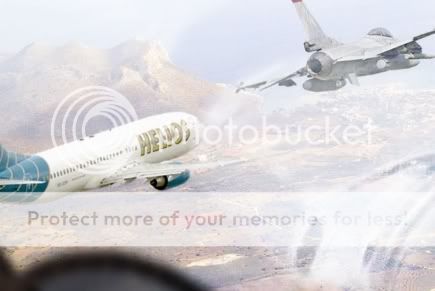
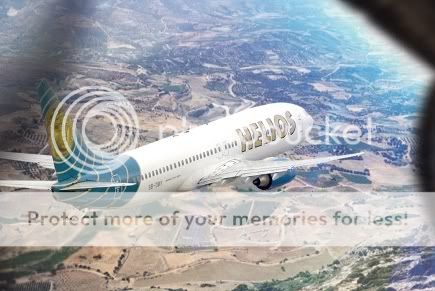

The plane in the Hilos flight 522 that was operated was a Boeing 737-300 they (the picture) show a Helios 737-800, rather than the -300. Efforts to disguise this have been made by doctoring the registration to that of the crashed aircraft.
The other key giveaways that the aircraft is an -800 rather than a -300, are the twin overwing exits, its fuselage length and trailing edge configuration.
Anyways the next thing I've found it a series of 3 shots that depict Helios Flight 522. The following is a backgrounder on the flight.
The flight, which left Larnaca, Cyprus at 09:07 local time, was en route to Athens, and was scheduled to continue to Prague. After the flight failed to contact air traffic control upon entering Greek air space, two F-16 fighter aircraft from the Hellenic Air Force 111th Combat Wing were scrambled from Nea Anchialos Air Base to establish visual contact. They noted that the aircraft appeared to be on autopilot. In accord with the rules for handling "renegade" aircraft incidents (where the aircraft is not under pilot control), one fighter approached to within 300 feet (100 m) of the ill-fated aircraft. The fighter pilot saw that the first officer was slumped motionless on the controls, and that the captain was not in the cockpit. Oxygen masks were seen dangling in the cabin.
Somewhat later, the F-16 pilots saw someone enter the cockpit and sit at the controls, soon to be joined by another person where the first officer had been sitting, both seemingly trying to regain control of the aircraft. Within minutes, first one engine, then the other ran out of fuel and the aircraft crashed into a hill, scattering wreckage and bodies and bursting into flame
The crash wzs the worst for deaths until a couple weeks later when West Caribbean Airways Flight 708 crashed. The Helios flight took the lives of 121 people. With all of this inmind the fact that supposed images on the internet came to light seems a little twisted but sparked huge interest. After just a couple hours questions emerged about the photos.



The plane in the Hilos flight 522 that was operated was a Boeing 737-300 they (the picture) show a Helios 737-800, rather than the -300. Efforts to disguise this have been made by doctoring the registration to that of the crashed aircraft.
The other key giveaways that the aircraft is an -800 rather than a -300, are the twin overwing exits, its fuselage length and trailing edge configuration.
On a revived thread an artical was posted by mister lear questioning about an articale posted in a french new paper about the crash of a 2nd F-117 in
the Kosovo airwar. Here is the article in question.
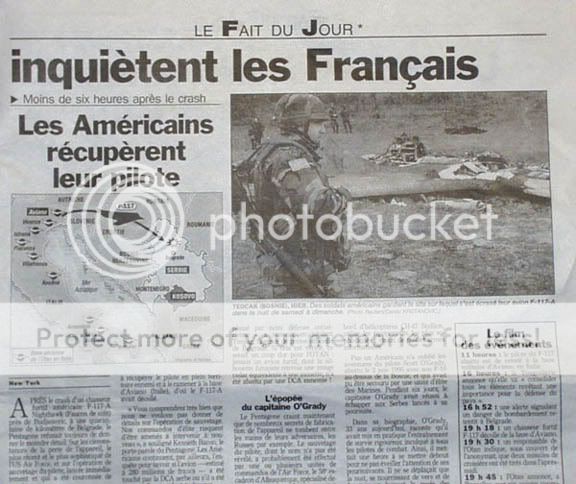
There are a number of problems with this photo as pointed out in the photo below. There are remains of a twin tail in the photo. While the F-117 does have a twin tail it is very different then the one in the photo which is that of a Mig-29 Fulcrum. Also the internal components are deffently not that of the F-117 and the missle is an A2A AA-10 infared missile whish defently would not be on a USAF stealth aircraft unless there is something we are missing.
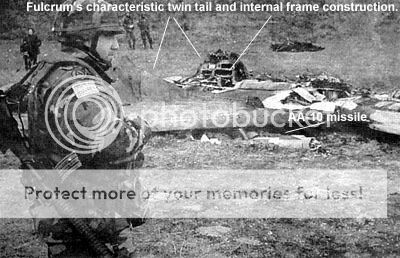
Thread: www.abovetopsecret.com...

There are a number of problems with this photo as pointed out in the photo below. There are remains of a twin tail in the photo. While the F-117 does have a twin tail it is very different then the one in the photo which is that of a Mig-29 Fulcrum. Also the internal components are deffently not that of the F-117 and the missle is an A2A AA-10 infared missile whish defently would not be on a USAF stealth aircraft unless there is something we are missing.

Thread: www.abovetopsecret.com...
Here is an update to the 3 seat F-14 photo. Just a bit more discription and posting of the actual photos. The Aircraft in question is Tomcat 106 which
is seen in one of the following pictures with just a dual seat config. The reflection and cabling from the pilots canopy to the third is identical.
Also the 3 diagonial bars under the cockpit is from the Pukin dogs livery. The pukin dogs neverr flew a 3 seat let alone 4! Here are the images.
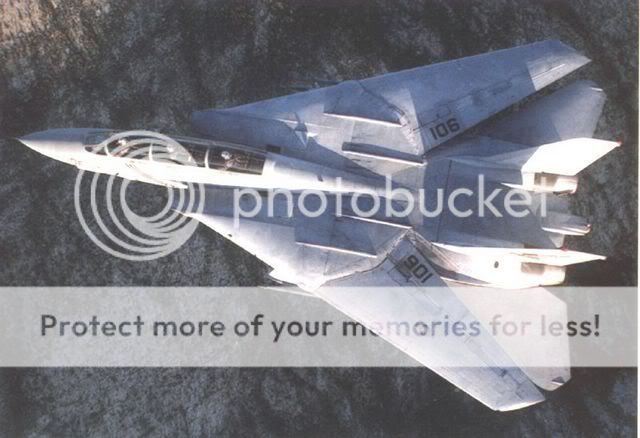
The orginal faked image. (if anyone can find the true 2 seat orginal that would be great!)
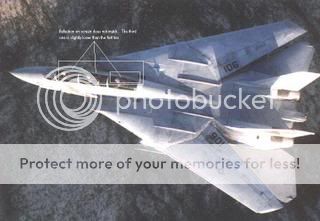
pointing out the reflection flaws. The 2nd canopies reflection ends in the corner making the 3rd canopy reflection inaccurate.
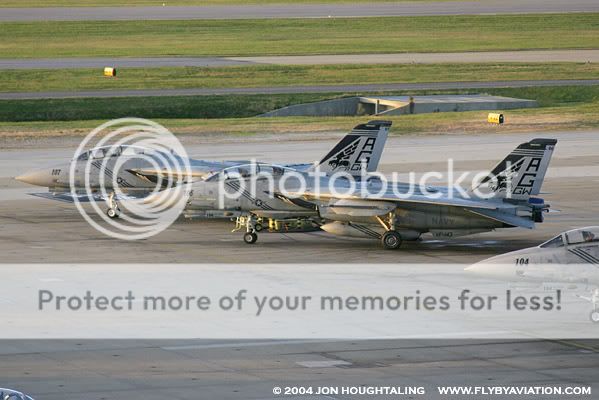
And finally the original aircraft in question. In a seperate shot.
Also There was mention of the EF-14 in the orginal thread. www.abovetopsecret.com... The photo supplied looked fake to begin with and had wrong all over it but to be safe the original was found.

The image in question. note the #501 and the white lettering on the tail. Also the fact the dome shadow goes to the top right and the planes shadow is to the bottom left.

The orginal with the #201 and the white lettering of NASA.

The orginal faked image. (if anyone can find the true 2 seat orginal that would be great!)

pointing out the reflection flaws. The 2nd canopies reflection ends in the corner making the 3rd canopy reflection inaccurate.

And finally the original aircraft in question. In a seperate shot.
Also There was mention of the EF-14 in the orginal thread. www.abovetopsecret.com... The photo supplied looked fake to begin with and had wrong all over it but to be safe the original was found.

The image in question. note the #501 and the white lettering on the tail. Also the fact the dome shadow goes to the top right and the planes shadow is to the bottom left.

The orginal with the #201 and the white lettering of NASA.
By popular demand I now bring your the Aurora!
In truth the issue behind the Aurora and if it ever was an operational plane or still is one today is something that the public is in the dark about, but through the years many people have claimed to have caught it on film. Now images of little specs aren't worth ones time but ones that you can distinguish shape size etc are a little better. I've already shown 2 other examples earlier in this thread but one that has been glossed over a bit is the cover of the 1986 issue of Discover magizine.
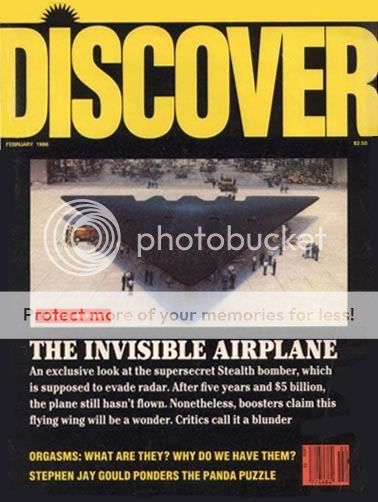
This is the issue in question. Its a good photoshop job but the shadows don't line up in comparison to that of the hanger and the plane and also the fact that 90% of the people are directly under the plane is odd and the equipment which is normally keep at a bit of a distance is directly under the plane. To prove this photo 100% wrong though I will still need to find the original which was probably taken at the Dryden test center of another plane. Or we can ask Discover mag if they faked it (even quicker)
What we can prove 100% that the 2nd photo has been manipulated and is a rip off of the 1st and miss represented. Its been put in a need backgroudn maybe even actually photographed to look more realistic after its been altered.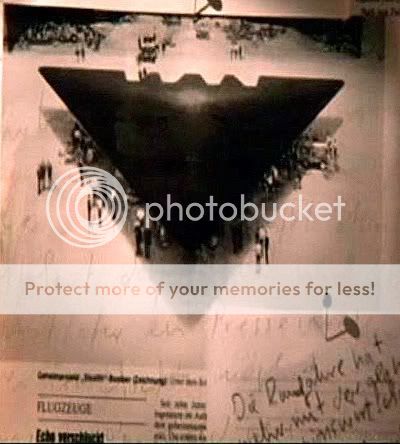
What gives it away is the fact that the people and the equipement have been stretched vertically and the horizontal size of the image has been shrunk.compressed inwards making everyone look humanoid as I've showen below. Also want to give a quick thanks to Bios for helping out with providing the images. But if anyone can track down the photo from the original that would be awesome. Till then I'll hunt for it.
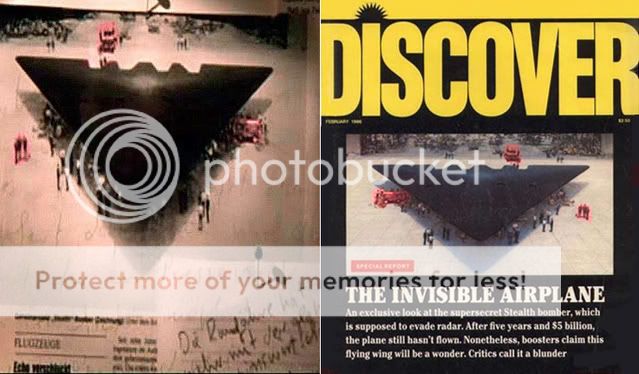
In truth the issue behind the Aurora and if it ever was an operational plane or still is one today is something that the public is in the dark about, but through the years many people have claimed to have caught it on film. Now images of little specs aren't worth ones time but ones that you can distinguish shape size etc are a little better. I've already shown 2 other examples earlier in this thread but one that has been glossed over a bit is the cover of the 1986 issue of Discover magizine.

This is the issue in question. Its a good photoshop job but the shadows don't line up in comparison to that of the hanger and the plane and also the fact that 90% of the people are directly under the plane is odd and the equipment which is normally keep at a bit of a distance is directly under the plane. To prove this photo 100% wrong though I will still need to find the original which was probably taken at the Dryden test center of another plane. Or we can ask Discover mag if they faked it (even quicker)
What we can prove 100% that the 2nd photo has been manipulated and is a rip off of the 1st and miss represented. Its been put in a need backgroudn maybe even actually photographed to look more realistic after its been altered.

What gives it away is the fact that the people and the equipement have been stretched vertically and the horizontal size of the image has been shrunk.compressed inwards making everyone look humanoid as I've showen below. Also want to give a quick thanks to Bios for helping out with providing the images. But if anyone can track down the photo from the original that would be awesome. Till then I'll hunt for it.

Well Its time to add another image to the debunked section. Its been a bit since I posted the last one but this older fake has been brought up in the
popular photos thread. The debunking is regarding the image of a 747-233 of Air Canada exploding on landing at a airport. Here is the image for those
who haven't seen it.
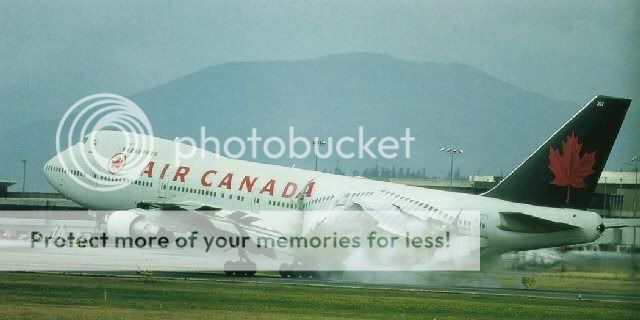
There is a number of things in this photo that point it out as a fake some are more solid proof then others. First on just a pure photo idea look at how the white on the forward part of the fuselage seems almost yellowish, but is more "pure" in the area where the plane is apparently cracking up.
Second the history of the 747 fleet for Air Canada never involved a crash of any sort. There where 15 aircraft of different versions. The version the 200 that we are interested in had 3 aircraft bought. 2 where stored when they outlived their use and 1 was sent to another operator. Right there that should be the end of it but to understand how this photo was made lets continue.
Third the image that was super imposed over the 747 landing was taken during a test done by Boeing on containing explosions by different pallet designs. The test 747-100 aircraft was pressurized to around an 8psi differential (+26.7psi inside versus +14.7psi outside) to simulate cruising at altitude. When the small amount of explosive went off in conjunction with the pressurization it resulted in a explosion relative to 30,000 ft (cruising alt) but the actual aircraft would not be pressurized like that on landing hence even if the explosion occurred at the time of the fake image the explosion would not look like the above fake photo.
Here is the real story. As told by one of the people that was involved in the actual test that involved a MD-10 as well.
The following is actual video of the test which you can tell the photo of the rear section was took during and the super imposed over the AC jet.
And for your convenience here are the stills. If you look at the third from the left photo it all becomes quite clear.


There is a number of things in this photo that point it out as a fake some are more solid proof then others. First on just a pure photo idea look at how the white on the forward part of the fuselage seems almost yellowish, but is more "pure" in the area where the plane is apparently cracking up.
Second the history of the 747 fleet for Air Canada never involved a crash of any sort. There where 15 aircraft of different versions. The version the 200 that we are interested in had 3 aircraft bought. 2 where stored when they outlived their use and 1 was sent to another operator. Right there that should be the end of it but to understand how this photo was made lets continue.
Third the image that was super imposed over the 747 landing was taken during a test done by Boeing on containing explosions by different pallet designs. The test 747-100 aircraft was pressurized to around an 8psi differential (+26.7psi inside versus +14.7psi outside) to simulate cruising at altitude. When the small amount of explosive went off in conjunction with the pressurization it resulted in a explosion relative to 30,000 ft (cruising alt) but the actual aircraft would not be pressurized like that on landing hence even if the explosion occurred at the time of the fake image the explosion would not look like the above fake photo.
Here is the real story. As told by one of the people that was involved in the actual test that involved a MD-10 as well.
There were actually 4 explosions, all of the same size/composition. Three explosions were contained by the various containment systems designed by both American and British companies. The fourth (only one seen in the video) is a "control" explosion...to see what an uncontained explosion would do.
The following is actual video of the test which you can tell the photo of the rear section was took during and the super imposed over the AC jet.
And for your convenience here are the stills. If you look at the third from the left photo it all becomes quite clear.

A quicker one this time. Here is the culprit image. Its a photo of a B-52 doing a flyby of a aircraft carrier... inverted. Sorta grainy shot and so
on. What is the real story here.
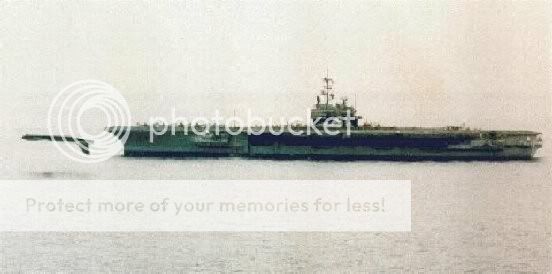
Well lets see here. Its a B-52 with full flaps inverted at 50 ft off the waters surface.... story closed it does work. The photos has been tampered with to change the B-52 to make it look like its inverted but its not really. You can even see the box where the person selected the B-52 and then inverted it if you look close.
The real photo is this next one and its much more believable.

Now there may still be some question of what is it doing there and why is its nose pointed so low etc so I'll go out a a limb here with some answers and a story.
The nose down attitude is normal for a B-52 when it comes in for landing approaches due to a number of factors. With full flap deployment, the new angle of attack relative to the angle of incidence (position of the wing relative to the aircraft) is roughly 20 degrees. With full flaps down and at near maximum flap ext. speed the aircraft would have a 5-10 degree nose down attitude. Retract the flaps and you would have a 5-10 degree nose up attitude.
Also I just stumbled on another photo of the same flyby. Here it is

Of note as well is the Helo that looks like a SeaKing in the background the the orginal photo may have been shot from. Just more then likely
As for the story here well this is how it supposedly goes as told by a poster some where else on the web who was there.
[edit on 22/08/06 by Canada_EH]

Well lets see here. Its a B-52 with full flaps inverted at 50 ft off the waters surface.... story closed it does work. The photos has been tampered with to change the B-52 to make it look like its inverted but its not really. You can even see the box where the person selected the B-52 and then inverted it if you look close.
The real photo is this next one and its much more believable.

Now there may still be some question of what is it doing there and why is its nose pointed so low etc so I'll go out a a limb here with some answers and a story.
The nose down attitude is normal for a B-52 when it comes in for landing approaches due to a number of factors. With full flap deployment, the new angle of attack relative to the angle of incidence (position of the wing relative to the aircraft) is roughly 20 degrees. With full flaps down and at near maximum flap ext. speed the aircraft would have a 5-10 degree nose down attitude. Retract the flaps and you would have a 5-10 degree nose up attitude.
Also I just stumbled on another photo of the same flyby. Here it is

Of note as well is the Helo that looks like a SeaKing in the background the the orginal photo may have been shot from. Just more then likely
As for the story here well this is how it supposedly goes as told by a poster some where else on the web who was there.
This picture was taken in the spring of 1990 as we started our deployment on the Ranger to the Persian Gulf.
I was up in the "tower" with the air boss as the Viking squadron rep for the launch/recovery and these Buff drivers (2 of them) called that they were at 8 miles for a flyby. They had been 'orange air' for a big war - at - sea exercise we were doing When they called at 5 miles the boss said "we don't see you" and we heard back "look low". Out on the water we saw this smoke trail first, (the planes merged with the color of the water) at about a 1-2 miles we could break them out and the two buffs came by at 20-30 feet off the water splitting the ship at about 350kts. Then they pulled up and did a big plan form 180 and said "do you want to see that again" - The air boss said "hell yea" so they went back out an did it again.
It was the only time in my 20 year career that I have seen any services jets purposely flying below flight deck level.
[edit on 22/08/06 by Canada_EH]
It seems to be a all Canada thread at this point lol. The idea is though that anyone can still post their own discovered fake images or if they have
question if one is or not. Till then I'll keep posting the images that I do find myself every so often.
The image this time is of a Boeing 777-233ER of American Airlines that appears to have suffered a birdstrike and massive engine failure. The end result being a massive fireball around the engine seen here.

When you look at the photo some things become apparent about the fireball and lighting etc. Do you see any highlight from the fireball on the fuselage of the aircraft? Thats a shiny AA aircraft so the fact its not there is a huge give away same with the runway under the aircraft.
Here is the real photo. Identical in everyway but the very fake/pixled fireball.
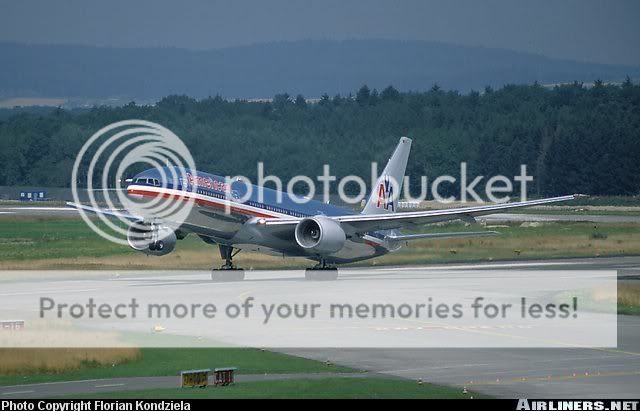
The orginal shot was taken by Florian Kondziela and is currently still posted on Airliners.net as well. Who I'me sure would say there was no engine fireball that day.
www.airliners.net...
[edit on 8-1-2008 by Canada_EH]
The image this time is of a Boeing 777-233ER of American Airlines that appears to have suffered a birdstrike and massive engine failure. The end result being a massive fireball around the engine seen here.

When you look at the photo some things become apparent about the fireball and lighting etc. Do you see any highlight from the fireball on the fuselage of the aircraft? Thats a shiny AA aircraft so the fact its not there is a huge give away same with the runway under the aircraft.
Here is the real photo. Identical in everyway but the very fake/pixled fireball.

The orginal shot was taken by Florian Kondziela and is currently still posted on Airliners.net as well. Who I'me sure would say there was no engine fireball that day.
www.airliners.net...
[edit on 8-1-2008 by Canada_EH]
OK, OK, I felt it was time to give a mate some support. I have nothing to offer the thread Canada, (other than making it no longer exclusively
Canadian that is! ) other than my appreciation and support. YES at least one person is taking notice of what you are doing, keep up the good
work.
LEE.
LEE.
reply to post by thebozeian
Haha Thanks Boz great to see some more posts from you. Keep us updated on any crazy stories that I'm sure your going to hear much like Zaph has gotten when your involved with all the many planes and instructors over the past bit.
On the debunking images idea though when you (or anyone else for that matter) run across something please post EH!
Haha Thanks Boz great to see some more posts from you. Keep us updated on any crazy stories that I'm sure your going to hear much like Zaph has gotten when your involved with all the many planes and instructors over the past bit.
On the debunking images idea though when you (or anyone else for that matter) run across something please post EH!
Well I'm starting to enjoy finding these photos and their stories and real origins but this next one most of us have seen and it makes the majority
cringe. Its the photo of a simple tourist on the WTC observation deck with a airliner in the background in what appears to be seconds before the
crash. The story attached to the image is as follows.

No wonder people jumped all over this image, but it didn't take long for some people to start to see problems with the image. Some of the key problems where the following.
-The plane in the picture is a Boeing 757. The only American Airlines plane that crashed was a Boeing 767 of flight 11.
-The picture shows the approach of a plane on the northern side of one of the towers. The only plane that came from the north was the one that hit Tower 1 ... but Tower 1 did not have an observation Deck. Tower 2 does ... but it didn't open until 9:30 a.m., well after the first and second attacks.
-Why is this guy wearing a winter jacket? September 11, 2001 was a warm, Indian summer day (65 and 70 degrees). The top of the Trade Center might be cooler thanks to wind, but it's unlikely this guy would be wearing a winter jacket.
-Why isn't the fast-moving aircraft blurry in the photo?
In fact the orginal shot of the 757 is most likely this image from airliners.net which was shot by Jonathan Derden and the fake is mentioned in the link. www.airliners.net...
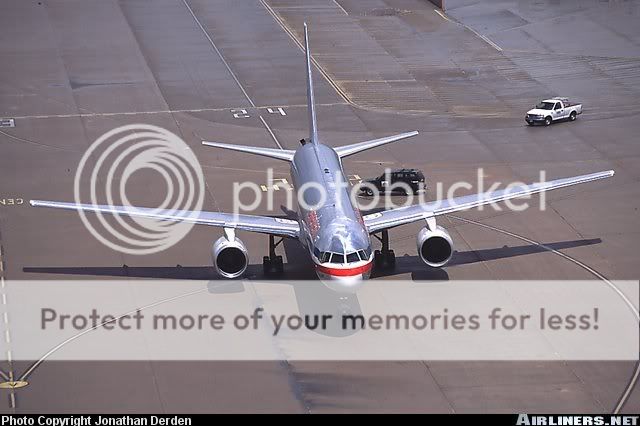
The question of who was the tourist in the photo also sparked some discussion and to see if the actual person in the photo would come forward. In Decembed 2001 a Hungarian named Peter came forward and provide another photo of him for the same day.
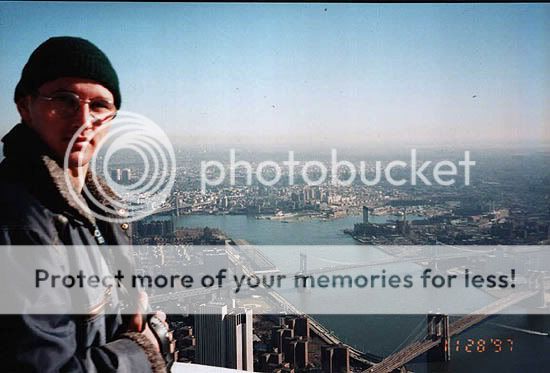

"A photo from a camera with pictures that had been taken on the trade building of a tourist and the plane is heading behind him to hit the building. The camera was found by rescue workers and developed.
I received this e-mail from a retired firefighter neighbor of ours who received it from a firefighter he worked with in Coronado, CA. He volunteered to be on the search and rescue mission and is there for 10 days. It is hard to believe it when you see it and wonder if the person taking the picture realized the plane was going to hit the center. They still don't know who the person is."
No wonder people jumped all over this image, but it didn't take long for some people to start to see problems with the image. Some of the key problems where the following.
-The plane in the picture is a Boeing 757. The only American Airlines plane that crashed was a Boeing 767 of flight 11.
-The picture shows the approach of a plane on the northern side of one of the towers. The only plane that came from the north was the one that hit Tower 1 ... but Tower 1 did not have an observation Deck. Tower 2 does ... but it didn't open until 9:30 a.m., well after the first and second attacks.
-Why is this guy wearing a winter jacket? September 11, 2001 was a warm, Indian summer day (65 and 70 degrees). The top of the Trade Center might be cooler thanks to wind, but it's unlikely this guy would be wearing a winter jacket.
-Why isn't the fast-moving aircraft blurry in the photo?
In fact the orginal shot of the 757 is most likely this image from airliners.net which was shot by Jonathan Derden and the fake is mentioned in the link. www.airliners.net...

The question of who was the tourist in the photo also sparked some discussion and to see if the actual person in the photo would come forward. In Decembed 2001 a Hungarian named Peter came forward and provide another photo of him for the same day.

The photo of the Tourist Guy shows the Brooklyn bridge (bottom right) and Manhattan bridge. The picture carries a date-stamp nearly four years before the WTC attacks.
How about another?
In the past couple days I've just been finding alot of these "images" and so on. Usally on websites that offer some of the explination and I just take it apon myself to and a bit more of a aviation focus on some of the subjects.
The Next images is that of what was paraded around emails after the Columbia re-entry breakup as in orbit shots of the shuttle break up which looks like more of explosion of sorta while in orbit. Here is the back story
The following is 3 of the 8-9 images that was attached to the email.



Well I guess its about time to give the simple answer to this poorly presented and created fake story and images. Have your ever watched Armageddon? Those images have been taken from the movie as still frame captures during the first * min of the movie. A shuttle is hit in orbit by meteor fragments and the above images are the result.
Even if we hadn't been able to establish their fictitious origin, argues Rob Rosenberger of Vmyths.com, the "photos" themselves are inherently unbelievable.
And another one bites the dust. This series of images and the WTC images really show the interest that morbid images can create from normal people. And like usual we can only guess what the creator of these images was trying to do when he created the story and took the images and sent them on their merry way.
In the past couple days I've just been finding alot of these "images" and so on. Usally on websites that offer some of the explination and I just take it apon myself to and a bit more of a aviation focus on some of the subjects.
The Next images is that of what was paraded around emails after the Columbia re-entry breakup as in orbit shots of the shuttle break up which looks like more of explosion of sorta while in orbit. Here is the back story
A friend of a friend forwarded the following:
"Got these from a friend of mine who is a retired NASA space engineer. Haven't seen anything like this on the news yet. "
These photos of the shuttle explosion are very graphic but are outstanding in their clarity and detail. They were taken (I was told) by an Israeli satellite and have not yet been released by the U.S. Government. I thought you might want to see them if they haven't been sent to you already.
The following is 3 of the 8-9 images that was attached to the email.



Well I guess its about time to give the simple answer to this poorly presented and created fake story and images. Have your ever watched Armageddon? Those images have been taken from the movie as still frame captures during the first * min of the movie. A shuttle is hit in orbit by meteor fragments and the above images are the result.
Even if we hadn't been able to establish their fictitious origin, argues Rob Rosenberger of Vmyths.com, the "photos" themselves are inherently unbelievable.
First, they suggest we (or the Israelis) keep a satellite in extraordinarily low orbit, close enough to the shuttle to take high-res pictures of its reentry. We know this because the pictures show the shuttle in a head-on view, slightly from below, rather than from above.
"Second, it suggests the NRO (National Reconnaisance Office) released photos in extraordinary wide-angle, 'movie-quality' detail, thereby giving our enemies a clue as to our best resolution.
"Third, the configuration of the blast in later pictures suggests the shuttle carries fuel in areas not previously known to carry fuel. A typical Hollywood cliché — when a fuel tank blows up, the entire vehicle blows up in unison, in place."
And another one bites the dust. This series of images and the WTC images really show the interest that morbid images can create from normal people. And like usual we can only guess what the creator of these images was trying to do when he created the story and took the images and sent them on their merry way.
This is a photo of a DC-9 taking off from St Maartens in the Netherlands Antilles. The photo has created a stir like a number of St Maarten photos do
of being a fake. The runway at the airport is reknowned for its threshhold being very close to the beach and is only seperated by a road and a small
fence.
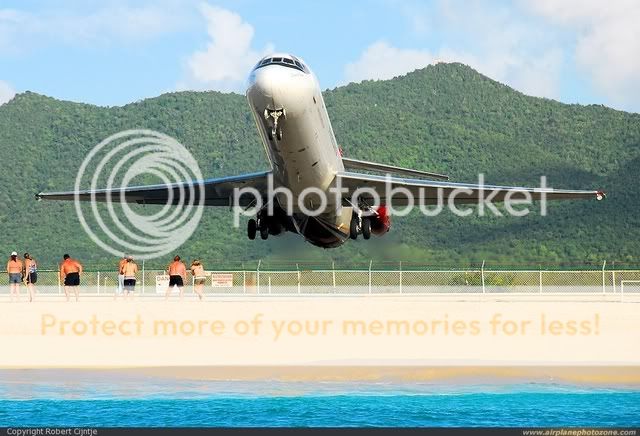
The runway is less then 7200ft at St Maarten and as shuch when aircraft are able to they like to take off on runway 27 which is towards the ocean instead of runway 9 which is towards the terrain which has a steeper climb out. It seems this DC-9 from Aserca Airlines was shot taking off from runway 27 from a small boat near the beach. And to put neah sayers to rest here is the take off sequence that was shot by Robert Cijntje on Jan 7 2008.

And just to put the DC-9 photo into context on size of people etc at the angle here is another shot of 757 from US Airways landing on runway 9 at St Maarten.
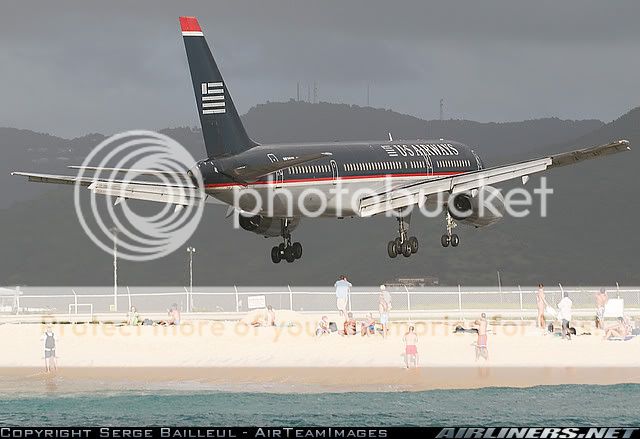

The runway is less then 7200ft at St Maarten and as shuch when aircraft are able to they like to take off on runway 27 which is towards the ocean instead of runway 9 which is towards the terrain which has a steeper climb out. It seems this DC-9 from Aserca Airlines was shot taking off from runway 27 from a small boat near the beach. And to put neah sayers to rest here is the take off sequence that was shot by Robert Cijntje on Jan 7 2008.

And just to put the DC-9 photo into context on size of people etc at the angle here is another shot of 757 from US Airways landing on runway 9 at St Maarten.

FA my personal feeling is that the photo you posted has been manipulated in some way to put the AA plane lower then it actually was. It wouldn't take
much to make it seem really low on a approach that is already known for its low approach.
Can you provide a link where you found the image?
If you look at reflections on the polished underside and the shadow on the engine nacelles and the thresh hold it seems to match still. The height is just ridiculous and some one moving it in PS seems likely. I some how doubt that women would be so calm.
Again all of these are just thoughts on a photo that is very interesting and doesn't have or seem to have any blatant flaws.
Can you provide a link where you found the image?
If you look at reflections on the polished underside and the shadow on the engine nacelles and the thresh hold it seems to match still. The height is just ridiculous and some one moving it in PS seems likely. I some how doubt that women would be so calm.
Again all of these are just thoughts on a photo that is very interesting and doesn't have or seem to have any blatant flaws.
Well a video has appeared on you tube and Airliners.net again that sorta makes its rounds every so often. It features a Para sail surfer being caught
on the edge of a A320 wing as the plane comes in to land. Here is the link to the Video (sorta looks like fun to me :up
Well most people would look at that and go huh? how is that even possible? With good reason and good reasoning is alone enough to dispel this video. First off what commercial airport do you know that allows kiteboarding at the end of their runway? The Para sails used for this type of surfing are not strong sails. They have been known to break upon getting caught or pulled in a tree etc. Also the length of the cords used to control the sail are usually around 30-40 meters long (not final approach height of a plane). The jump height that the surfer got also was only about 10-15 meters high in this video before disappearing. Total eight of his sail max 60-65 meters.
The nail in the coffin however is much the same as the bouncing landing A320. This video was a commercial used by Sprite for "friends come and go" which was a series of video with similar humor.
Here is I link I found just now to the whole commercial as well.
[edit on 4-3-2008 by Canada_EH]
[edit on 4-3-2008 by Canada_EH]
Well most people would look at that and go huh? how is that even possible? With good reason and good reasoning is alone enough to dispel this video. First off what commercial airport do you know that allows kiteboarding at the end of their runway? The Para sails used for this type of surfing are not strong sails. They have been known to break upon getting caught or pulled in a tree etc. Also the length of the cords used to control the sail are usually around 30-40 meters long (not final approach height of a plane). The jump height that the surfer got also was only about 10-15 meters high in this video before disappearing. Total eight of his sail max 60-65 meters.
The nail in the coffin however is much the same as the bouncing landing A320. This video was a commercial used by Sprite for "friends come and go" which was a series of video with similar humor.
Here is I link I found just now to the whole commercial as well.
[edit on 4-3-2008 by Canada_EH]
[edit on 4-3-2008 by Canada_EH]
Well it has been awhile but there has been a new post of a photoshopped image that I had completely forgot about. Today's fake is courtesy of fellow
Aviation poster Harlequin and original thread can be located here:
www.abovetopsecret.com...
Well to start off this faked image comes from:
www.steelsoldiers.com...
Where even posters they hint at it being faked. The image in question is the one below.

Now lets be clear the issue with this image isn't the fact that it is surrounded by a vapor cloud (mind you the size of the prandtl-glauert cloud is much to large). Its that there are those out there that post this image claiming the B-52 is capable of mach 1 which it is not.
The image below is a highly distributed image of a F-18C of the US Navy creating its own prandtl-glauert cloud which if you look is the one that was taken and used to photoshop the B-52 image. These high speed pass are usually around the near 750 MPH range. This is a full 100 mph faster then the B-52s published VNE.
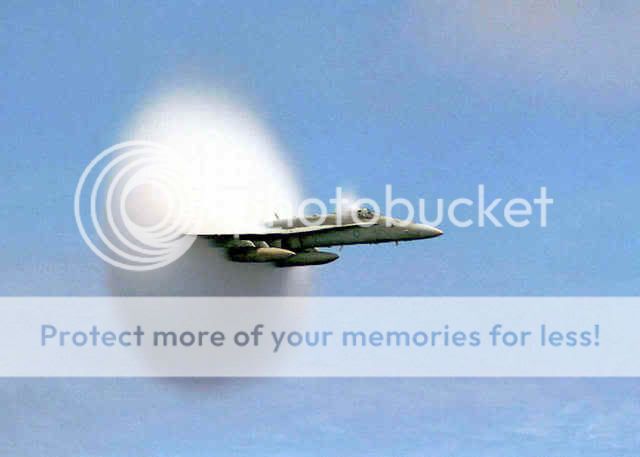
[edit on 8-7-2008 by Canada_EH]
www.abovetopsecret.com...
Well to start off this faked image comes from:
www.steelsoldiers.com...
Where even posters they hint at it being faked. The image in question is the one below.

Now lets be clear the issue with this image isn't the fact that it is surrounded by a vapor cloud (mind you the size of the prandtl-glauert cloud is much to large). Its that there are those out there that post this image claiming the B-52 is capable of mach 1 which it is not.
The image below is a highly distributed image of a F-18C of the US Navy creating its own prandtl-glauert cloud which if you look is the one that was taken and used to photoshop the B-52 image. These high speed pass are usually around the near 750 MPH range. This is a full 100 mph faster then the B-52s published VNE.

[edit on 8-7-2008 by Canada_EH]
Great job so far! As a fellow Canadian I would like to add something. I don't think this
has been posted yet. The second one dow has, The one I mean specifically is the top one. Read the link, it's got many things wrong with it.
P.S. If that book comes I would like a copy.
P.S. If that book comes I would like a copy.
reply to post by W35M4N
Thanks for the post W35M4N
I'll be sure to expand on the image you linked so as to have the imagery and story posted directly here on the forum. As for the book I'm surely a long way off of thinking of doing one a .pdf of some sort or a rough draft that can be shared and added to would be a start to look at that I may work on in all my "down time".
Thanks for the post W35M4N
I'll be sure to expand on the image you linked so as to have the imagery and story posted directly here on the forum. As for the book I'm surely a long way off of thinking of doing one a .pdf of some sort or a rough draft that can be shared and added to would be a start to look at that I may work on in all my "down time".
Well here is a easy one that I stumbled on before I get to some others that I've found. Take a look at the image and if you can't spot why its a
fake I'd never trust yours eyes again
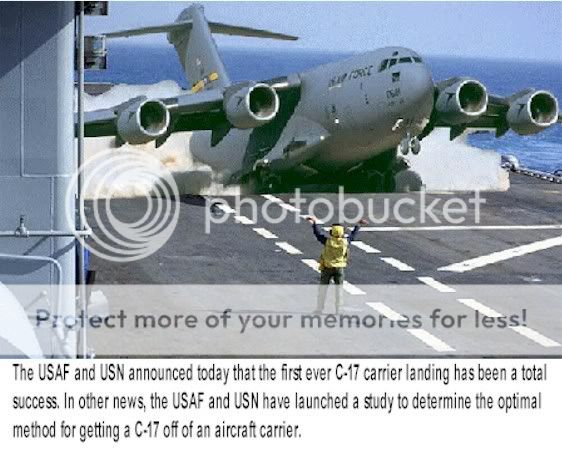
Here is the site with link:www.b-29s-over-korea.com...
Here is the original of the C-17

Now simply put here is the original photo of a C-17 in what appears to be landing configuration not over a carrier but out in what appears to be a new mexico dirt strip. I would say hence the dirt cloud that makes sense here but not in a carrier landing. Also Scale is an issue in the image as well as the the lighting is from opposite top corners of the image. Also I can see what I believe to be the nose of the true landing aircraft just between the "touchdown point" and edge of the island in the image.

Here is the site with link:www.b-29s-over-korea.com...
Here is the original of the C-17

Now simply put here is the original photo of a C-17 in what appears to be landing configuration not over a carrier but out in what appears to be a new mexico dirt strip. I would say hence the dirt cloud that makes sense here but not in a carrier landing. Also Scale is an issue in the image as well as the the lighting is from opposite top corners of the image. Also I can see what I believe to be the nose of the true landing aircraft just between the "touchdown point" and edge of the island in the image.
Well its time for another post to the thread and this one I need people to help out on a bit.
The image that needs debunking this time is one that I know for 100% is a fake but I can't find the original image. I've seen the original and I'm sure it is from Dryden Nasa testing ground. Anyways here is the image which I'm sure some of you have seen before.
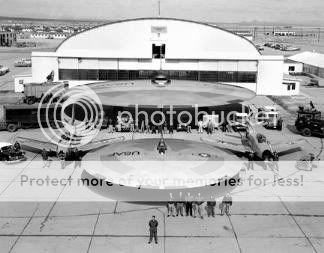
Also another image that I'm sure is faked but wondering about if anyone knows or has the original.

Now to try and get some back for my claims or to at least help anyone in the hunt here is what I have found. The image below is much the same minus the hanger that was shot in a around the same time frame as the fake. It shows the crew and support crew for the X-2 missions that were done. These style of image are very popular for the crews and development teams so they seem to have been done a number of the projects.
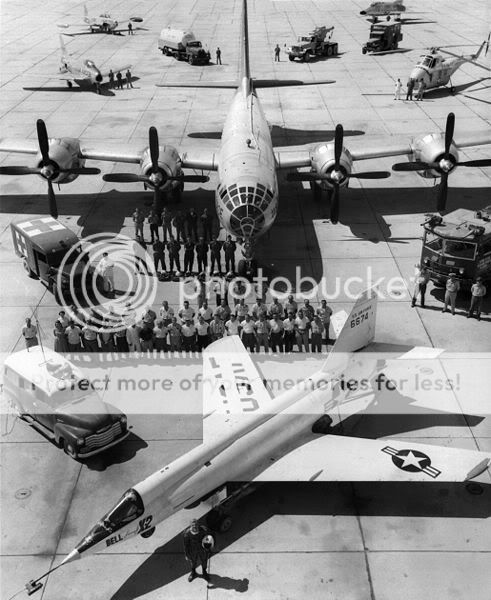
Also a image of the Hangar from the background as well which confirms it as from the Dryden hay day of testing.
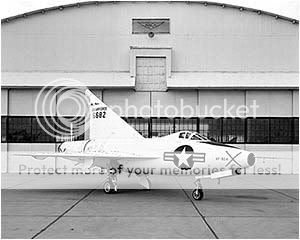
So the challenge is on! Lets nail this one down and get another fake off the net and these forums EH!
p.s. don't forget to flag the thread if you like it! We don't want this thread disappearing into the abyss.
[edit on 23-9-2008 by Canada_EH]
The image that needs debunking this time is one that I know for 100% is a fake but I can't find the original image. I've seen the original and I'm sure it is from Dryden Nasa testing ground. Anyways here is the image which I'm sure some of you have seen before.

Also another image that I'm sure is faked but wondering about if anyone knows or has the original.

Now to try and get some back for my claims or to at least help anyone in the hunt here is what I have found. The image below is much the same minus the hanger that was shot in a around the same time frame as the fake. It shows the crew and support crew for the X-2 missions that were done. These style of image are very popular for the crews and development teams so they seem to have been done a number of the projects.

Also a image of the Hangar from the background as well which confirms it as from the Dryden hay day of testing.

So the challenge is on! Lets nail this one down and get another fake off the net and these forums EH!
p.s. don't forget to flag the thread if you like it! We don't want this thread disappearing into the abyss.
[edit on 23-9-2008 by Canada_EH]
new topics
-
South Korea declares martial law for first time in 50 years over North Korea threat
Other Current Events: 1 hours ago -
Alien warfare predicted for December 3 2024
Aliens and UFOs: 5 hours ago
top topics
-
Alien warfare predicted for December 3 2024
Aliens and UFOs: 5 hours ago, 11 flags -
Could Biden pardon every illegal alien
Social Issues and Civil Unrest: 15 hours ago, 8 flags -
Statements of Intent from Incoming Trump Administration Members - 2025 to 2029.
2024 Elections: 14 hours ago, 8 flags -
Stop the Presses! Turkey Soup.
Food and Cooking: 16 hours ago, 5 flags -
South Korea declares martial law for first time in 50 years over North Korea threat
Other Current Events: 1 hours ago, 5 flags
active topics
-
President-Elect DONALD TRUMP's 2nd-Term Administration Takes Shape.
Political Ideology • 272 • : WeMustCare -
South Korea declares martial law for first time in 50 years over North Korea threat
Other Current Events • 16 • : WeMustCare -
Statements of Intent from Incoming Trump Administration Members - 2025 to 2029.
2024 Elections • 15 • : WeMustCare -
Alien warfare predicted for December 3 2024
Aliens and UFOs • 26 • : WeMustCare -
The Acronym Game .. Pt.4
General Chit Chat • 998 • : tinkerbell99 -
-@TH3WH17ERABB17- -Q- ---TIME TO SHOW THE WORLD--- -Part- --44--
Dissecting Disinformation • 3463 • : duncanagain -
Biden pardons his son Hunter despite previous pledges not to
Mainstream News • 125 • : xuenchen -
Australia passes social media ban for children under 16
Social Issues and Civil Unrest • 28 • : PorkChop96 -
Post A Funny (T&C Friendly) Pic Part IV: The LOL awakens!
General Chit Chat • 7865 • : underpass61 -
Could Biden pardon every illegal alien
Social Issues and Civil Unrest • 22 • : mysterioustranger
